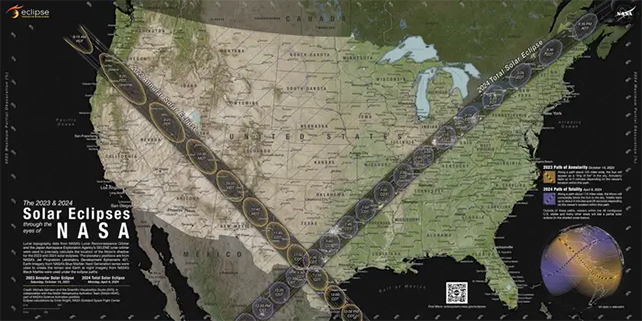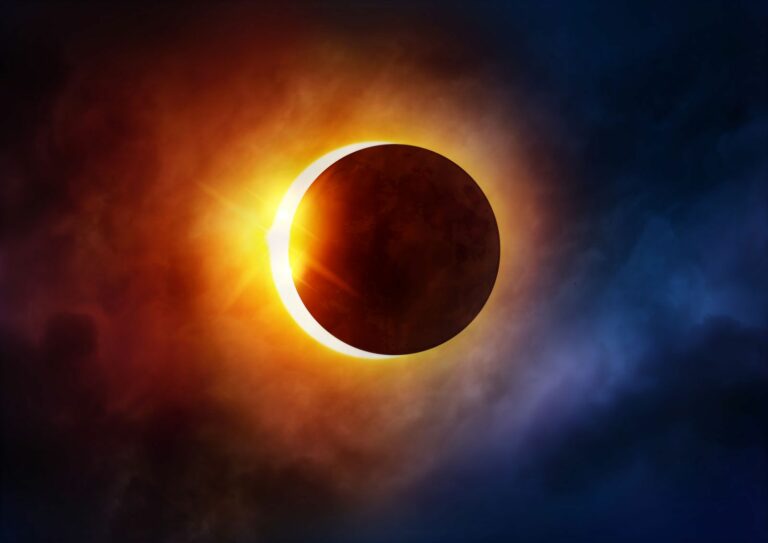Get Ready for a Mind-Blowing Solar Eclipse Crossing the US in 2024
On April 8, 2024, a significant number of individuals will have the opportunity to wear protective glasses and witness a remarkable total solar eclipse. This event may sound familiar to some, as a similar occurrence took place in 2017, where a 70-mile-wide strip of the United States experienced a total solar eclipse, while other regions witnessed a partial eclipse. The sight of the darkened sky in the middle of the day captivated people to the extent that they traveled across states and gathered near planetariums just to catch a glimpse of those fleeting moments.
However, the upcoming total eclipse in April is expected to be even more extraordinary, as enthusiastic NASA scientists shared with reporters at an American Geophysical Union meeting. Kelly Korreck, NASA’s program manager for the 2024 solar eclipse, expressed the sentiment that those who have witnessed eclipses before eagerly anticipate the opportunity to witness another one. The recent memory of the 2017 eclipse likely contributes to the excitement surrounding this year’s event.
While total solar eclipses are not exceedingly rare, there are several unique circumstances surrounding the upcoming eclipse that set it apart. These include its path across the United States, an abundance of solar activity, and a multitude of scientific projects planned by NASA and other organizations for the brief period when the Moon will appear to cover the Sun.
Over 30 million people will be able to see the total solar eclipse
There are three types of solar eclipses:
1- an annular eclipse appears as a bright ring around the Moon
2- a partial eclipse only partly blocks the Sun
3- in a total eclipse, the Moon seems to cover the Sun entirely
In 2017, a momentous event occurred as the continental US witnessed its first coast-to-coast total eclipse since 1918. Although the path encompassed portions of 14 states, bustling cities such as Atlanta and Charlotte, North Carolina, were unfortunately excluded from this celestial spectacle.
However, this year brings good news as a larger number of individuals will have the opportunity to witness the eclipse without the need for extensive travel. The path of this awe-inspiring phenomenon stretches all the way from Mexico to northeastern Canada, allowing more people to marvel at its grandeur.

Korreck stated that this eclipse is anticipated to be the most densely populated in the United States, with a staggering 31.5 million individuals having the opportunity to simply step outside their residences and witness this extraordinary phenomenon. Notably, Dallas, Cleveland, and Indianapolis are strategically located to offer optimal visibility for the total eclipse.
The eclipse will last slightly longer than the last one did
The duration of your viewing time for the Moon obscuring the Sun will vary depending on your location, typically ranging from 3 to 4 minutes. During the peak of the eclipse, known as totality, the duration will be slightly longer compared to the one that occurred in 2017, as mentioned by Korreck. If you are a resident of the United States and happen to miss this year’s eclipse, you will have to wait for a couple of decades for a similar event to occur. The next total solar eclipses visible in the contiguous US are scheduled for 2044 and 2045, but unfortunately, neither of them will pass through Cleveland or Indianapolis. As Korreck stated, it will be quite a while before you have the opportunity to witness another eclipse.
An active sun should make for incredible viewing
During the eclipse in 2017, the Sun remained relatively calm. However, as it approaches its solar maximum, it has been emitting solar flares. Korreck is hopeful to witness a coronal mass ejection (CME) during the eclipse. CMEs are rapid blobs of plasma that erupt from the Sun’s outer layer, known as the corona. According to Korreck, during that specific moment, one would witness an inky mass leaving the Sun, creating a truly spectacular sight. If this phenomenon occurs, Korreck predicts an increase in aurora borealis activity a few days later. Even without a CME, the images captured during the eclipse could be more dynamic than those from 2017, displaying wispy prominences radiating from the Sun. In Korreck’s words, the Sun should appear very intricate and complex.
Balloons, rockets, and citizen scientists will be tracking the eclipse
Solar eclipses hold great significance in the scientific community due to the unique opportunities they present for conducting experiments. According to Nour E. Raouafi, an astrophysicist from Johns Hopkins University, these celestial events allow scientists to explore phenomena that would otherwise be inaccessible. One notable example is the eclipse that occurred in 1919, which provided evidence supporting Albert Einstein’s theory of relativity. The upcoming total solar eclipse is expected to be the most widely observed in history, largely due to the involvement of NASA and other institutions. These organizations will employ various tools such as radar, balloons, spacecraft, and jets to conduct experiments and collect valuable data during the eclipse. NASA’s focus will be on monitoring changes in density, wind speed, and temperatures in the ionosphere, a region of the Earth’s upper atmosphere. Additionally, unlike the previous eclipse in 2017, there are now two Sun-observing spacecraft orbiting our star. This unprecedented opportunity allows NASA to closely study the Sun from two different space observatories, while simultaneously utilizing instruments on Earth to analyze the eclipse. Consequently, scientists anticipate obtaining the most comprehensive eclipse data to date. Furthermore, numerous citizen scientist projects are also underway, encouraging individuals to contribute their observations using tools such as Ham radios, telescopes, cameras, and phones. NASA hopes to gather a wealth of images, sounds, and data from these citizen scientists during the eclipse.
This article was originally published by Business Insider.
Do not forget to share your opinion with us to provide you with the best posts !





0 Comments